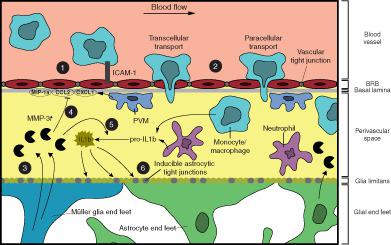Our official English website, www.x-mol.net, welcomes your
feedback! (Note: you will need to create a separate account there.)
Tightening the retinal glia limitans attenuates neuroinflammation after optic nerve injury.
Glia ( IF 5.4 ) Pub Date : 2020-07-09 , DOI: 10.1002/glia.23875 Evy Lefevere 1, 2 , Manuel Salinas-Navarro 1, 2 , Lien Andries 1, 2 , Lut Noterdaeme 1 , Isabelle Etienne 3 , Elien Van Wonterghem 4, 5 , Stefan Vinckier 6 , Benjamin M Davis 7 , Tine Van Bergen 3 , Inge Van Hove 1, 3 , Kiavash Movahedi 8, 9 , Roosmarijn E Vandenbroucke 4, 5 , Lieve Moons 1, 2 , Lies De Groef 1, 2
Glia ( IF 5.4 ) Pub Date : 2020-07-09 , DOI: 10.1002/glia.23875 Evy Lefevere 1, 2 , Manuel Salinas-Navarro 1, 2 , Lien Andries 1, 2 , Lut Noterdaeme 1 , Isabelle Etienne 3 , Elien Van Wonterghem 4, 5 , Stefan Vinckier 6 , Benjamin M Davis 7 , Tine Van Bergen 3 , Inge Van Hove 1, 3 , Kiavash Movahedi 8, 9 , Roosmarijn E Vandenbroucke 4, 5 , Lieve Moons 1, 2 , Lies De Groef 1, 2
Affiliation

|
Increasing evidence suggests that functional impairments at the level of the neurovascular unit (NVU) underlie many neurodegenerative and neuroinflammatory diseases. While being part of the NVU, astrocytes have been largely overlooked in this context and only recently, tightening of the glia limitans has been put forward as an important neuroprotective response to limit these injurious processes. In this study, using the retina as a central nervous system (CNS) model organ, we investigated the structure and function of the glia limitans, and reveal that the blood–retina barrier and glia limitans function as a coordinated double barrier to limit infiltration of leukocytes and immune molecules. We provide in vitro and in vivo evidence for a protective response at the NVU upon CNS injury, which evokes inflammation‐induced glia limitans tightening. Matrix metalloproteinase‐3 (MMP‐3) was found to be a crucial regulator of this process, thereby revealing its beneficial and immunomodulatory role in the CNS. in vivo experiments in which MMP‐3 activity was deleted via genetic and pharmacological approaches, combined with a comprehensive study of tight junction molecules, glial end feet markers, myeloid cell infiltration, cytokine expression and neurodegeneration, show that MMP‐3 attenuates neuroinflammation and neurodegeneration by tightening the glia limitans, thereby pointing to a prominent role of MMP‐3 in preserving the integrity of the NVU upon injury. Finally, we gathered promising evidence to suggest that IL1b, which is also regulated by MMP‐3, is at least one of the molecular messengers that induces glia limitans tightening in the injured CNS.
中文翻译:

收紧视网膜神经胶质限制可减轻视神经损伤后的神经炎症。
越来越多的证据表明,神经血管单元 (NVU) 水平的功能障碍是许多神经退行性疾病和神经炎症疾病的基础。虽然作为 NVU 的一部分,星形胶质细胞在这种情况下在很大程度上被忽视了,直到最近,才提出收紧神经胶质限制器作为限制这些损伤过程的重要神经保护反应。在这项研究中,我们使用视网膜作为中枢神经系统 (CNS) 模型器官,研究了神经胶质限制器的结构和功能,并揭示了血-视网膜屏障和神经胶质限制器作为协调的双重屏障来限制细胞浸润。白细胞和免疫分子。我们提供了体外和体内证据,证明中枢神经系统损伤时 NVU 的保护性反应会引起炎症诱导的神经胶质限制收紧。基质金属蛋白酶-3 (MMP-3) 被发现是该过程的关键调节剂,从而揭示其在中枢神经系统中的有益和免疫调节作用。通过遗传和药理学方法删除 MMP-3 活性的体内实验,结合对紧密连接分子、神经胶质末端标记、骨髓细胞浸润、细胞因子表达和神经变性的综合研究,表明 MMP-3 可减轻神经炎症和神经变性通过收紧神经胶质限制,从而表明 MMP-3 在损伤后保持 NVU 完整性方面的突出作用。最后,我们收集了有希望的证据,表明也受 MMP-3 调节的 IL1b 至少是诱导受损中枢神经系统神经胶质限制收紧的分子信使之一。
更新日期:2020-07-09
中文翻译:

收紧视网膜神经胶质限制可减轻视神经损伤后的神经炎症。
越来越多的证据表明,神经血管单元 (NVU) 水平的功能障碍是许多神经退行性疾病和神经炎症疾病的基础。虽然作为 NVU 的一部分,星形胶质细胞在这种情况下在很大程度上被忽视了,直到最近,才提出收紧神经胶质限制器作为限制这些损伤过程的重要神经保护反应。在这项研究中,我们使用视网膜作为中枢神经系统 (CNS) 模型器官,研究了神经胶质限制器的结构和功能,并揭示了血-视网膜屏障和神经胶质限制器作为协调的双重屏障来限制细胞浸润。白细胞和免疫分子。我们提供了体外和体内证据,证明中枢神经系统损伤时 NVU 的保护性反应会引起炎症诱导的神经胶质限制收紧。基质金属蛋白酶-3 (MMP-3) 被发现是该过程的关键调节剂,从而揭示其在中枢神经系统中的有益和免疫调节作用。通过遗传和药理学方法删除 MMP-3 活性的体内实验,结合对紧密连接分子、神经胶质末端标记、骨髓细胞浸润、细胞因子表达和神经变性的综合研究,表明 MMP-3 可减轻神经炎症和神经变性通过收紧神经胶质限制,从而表明 MMP-3 在损伤后保持 NVU 完整性方面的突出作用。最后,我们收集了有希望的证据,表明也受 MMP-3 调节的 IL1b 至少是诱导受损中枢神经系统神经胶质限制收紧的分子信使之一。











































 京公网安备 11010802027423号
京公网安备 11010802027423号